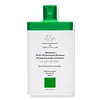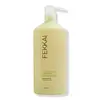What's inside
What's inside
 Key Ingredients
Key Ingredients

No key ingredients
 Benefits
Benefits

 Concerns
Concerns

 Ingredients Side-by-side
Ingredients Side-by-side

Water
Skin ConditioningSodium Cocoyl Isethionate
CleansingSodium Lauroyl Methyl Isethionate
CleansingSodium Lauroamphoacetate
CleansingGlycerin
HumectantCocamide Mipa
EmulsifyingCetyl Alcohol
EmollientPPG-3 Benzyl Ether Myristate
EmollientCaprylic/Capric Triglyceride
MaskingCoconut Acid
CleansingPolyester-37
Skin ConditioningSclerocarya Birrea Seed Oil
HumectantSilk Amino Acids
HumectantHydrolyzed Silk
HumectantSunflower Seed Oil Glycerides
EmollientSericin
Skin ConditioningDisunfloweroylethyl Dimonium Chloride
Lauryl Lactyl Lactate
Skin ConditioningTrisodium Ethylenediamine Disuccinate
Vanilla Planifolia Fruit Extract
Skin ConditioningCitric Acid
BufferingPolyquaternium-10
Polyquaternium-7
Acrylates/C10-30 Alkyl Acrylate Crosspolymer
Emulsion StabilisingCaprylyl Glycol
EmollientSodium Isethionate
CleansingSodium Benzoate
MaskingEthylhexylglycerin
Skin ConditioningHexylene Glycol
EmulsifyingPhenoxyethanol
PreservativePotassium Sorbate
PreservativeBenzyl Alcohol
PerfumingWater, Sodium Cocoyl Isethionate, Sodium Lauroyl Methyl Isethionate, Sodium Lauroamphoacetate, Glycerin, Cocamide Mipa, Cetyl Alcohol, PPG-3 Benzyl Ether Myristate, Caprylic/Capric Triglyceride, Coconut Acid, Polyester-37, Sclerocarya Birrea Seed Oil, Silk Amino Acids, Hydrolyzed Silk, Sunflower Seed Oil Glycerides, Sericin, Disunfloweroylethyl Dimonium Chloride, Lauryl Lactyl Lactate, Trisodium Ethylenediamine Disuccinate, Vanilla Planifolia Fruit Extract, Citric Acid, Polyquaternium-10, Polyquaternium-7, Acrylates/C10-30 Alkyl Acrylate Crosspolymer, Caprylyl Glycol, Sodium Isethionate, Sodium Benzoate, Ethylhexylglycerin, Hexylene Glycol, Phenoxyethanol, Potassium Sorbate, Benzyl Alcohol
Water
Skin ConditioningSodium Cocoyl Isethionate
CleansingSodium Lauroyl Methyl Isethionate
CleansingLauryl Glucoside
CleansingCocamide Mipa
EmulsifyingDisteareth-75 Ipdi
Olive Oil Glycereth-8 Esters
EmollientGlycerin
HumectantCoconut Acid
CleansingSodium Isethionate
CleansingOlea Europaea Fruit Oil
MaskingParfum
MaskingGlycol Stearate
EmollientPanthenol
Skin ConditioningLepidium Sativum Sprout Extract
Skin ConditioningOpuntia Ficus-Indica Stem Extract
Skin ConditioningLeontopodium Alpinum Extract
Skin ConditioningCaesalpinia Spinosa Fruit Extract
Skin ProtectingOryza Sativa Seed Protein
AntioxidantOryza Sativa Bran Extract
Skin ConditioningOryza Sativa Extract
AbsorbentHelianthus Annuus Sprout Extract
Skin ConditioningHelianthus Annuus Extract
EmollientRosmarinus Officinalis Leaf Extract
AntimicrobialGuar Hydroxypropyltrimonium Chloride
Skin ConditioningGlycol Distearate
EmollientTocopherol
AntioxidantMaltodextrin
AbsorbentCalcium Gluconate
HumectantGluconolactone
Skin ConditioningSodium Phytate
Phytic Acid
Potassium Sorbate
PreservativeSodium Benzoate
MaskingEthylhexylglycerin
Skin ConditioningChlorphenesin
AntimicrobialPhenoxyethanol
PreservativeLecithin
EmollientTrisodium Ethylenediamine Disuccinate
Benzyl Alcohol
PerfumingCitric Acid
BufferingPotassium Hydroxide
BufferingDisodium Phosphate
BufferingAlcohol
AntimicrobialLimonene
PerfumingLinalool
PerfumingHexyl Cinnamal
PerfumingHydroxycitronellal
PerfumingGeraniol
PerfumingWater, Sodium Cocoyl Isethionate, Sodium Lauroyl Methyl Isethionate, Lauryl Glucoside, Cocamide Mipa, Disteareth-75 Ipdi, Olive Oil Glycereth-8 Esters, Glycerin, Coconut Acid, Sodium Isethionate, Olea Europaea Fruit Oil, Parfum, Glycol Stearate, Panthenol, Lepidium Sativum Sprout Extract, Opuntia Ficus-Indica Stem Extract, Leontopodium Alpinum Extract, Caesalpinia Spinosa Fruit Extract, Oryza Sativa Seed Protein, Oryza Sativa Bran Extract, Oryza Sativa Extract, Helianthus Annuus Sprout Extract, Helianthus Annuus Extract, Rosmarinus Officinalis Leaf Extract, Guar Hydroxypropyltrimonium Chloride, Glycol Distearate, Tocopherol, Maltodextrin, Calcium Gluconate, Gluconolactone, Sodium Phytate, Phytic Acid, Potassium Sorbate, Sodium Benzoate, Ethylhexylglycerin, Chlorphenesin, Phenoxyethanol, Lecithin, Trisodium Ethylenediamine Disuccinate, Benzyl Alcohol, Citric Acid, Potassium Hydroxide, Disodium Phosphate, Alcohol, Limonene, Linalool, Hexyl Cinnamal, Hydroxycitronellal, Geraniol
Ingredients Explained
These ingredients are found in both products.
Ingredients higher up in an ingredient list are typically present in a larger amount.
Benzyl Alcohol is most commonly used as a preservative. It also has a subtle, sweet smell. Small amounts of Benzyl Alcohol is not irritating and safe to use in skincare products. Most Benzyl Alcohol is derived from fruits such as apricots.
Benzyl Alcohol has both antibacterial and antioxidant properties. These properties help lengthen the shelf life of products. Benzyl Alcohol is a solvent and helps dissolve other ingredients. It can also improve the texture and spreadability.
Alcohol comes in many different forms. Different types of alcohol will have different effects on skin. This ingredient is an astringent alcohol.
Using high concentrations of these alcohols are drying on the skin. They may strip away your skin's natural oils and even damage your skin barrier. Astringent alcohols may also irritate skin.
Other types of astringent alcohols include:
According to the National Rosacea Society based in the US, you should be mindful of products with these alcohols in the top half of ingredients.
Any type of sanitizing product will have high amounts of alcohol to help kill bacteria and viruses.
Learn more about Benzyl AlcoholCitric Acid is an alpha hydroxy acid (AHA) naturally found in citrus fruits like oranges, lemons, and limes.
Like other AHAs, citric acid can exfoliate skin by breaking down the bonds that hold dead skin cells together. This helps reveal smoother and brighter skin underneath.
However, this exfoliating effect only happens at high concentrations (20%) which can be hard to find in cosmetic products.
Due to this, citric acid is usually included in small amounts as a pH adjuster. This helps keep products slightly more acidic and compatible with skin's natural pH.
In skincare formulas, citric acid can:
While it can provide some skin benefits, research shows lactic acid and glycolic acid are generally more effective and less irritating exfoliants.
Most citric acid used in skincare today is made by fermenting sugars (usually from molasses). This synthetic version is identical to the natural citrus form but easier to stabilize and use in formulations.
Read more about some other popular AHA's here:
Learn more about Citric AcidWe don't have a description for Cocamide Mipa yet.
Coconut Acid isn't fungal acne safe.
Ethylhexylglycerin (we can't pronounce this either) is commonly used as a preservative and skin softener. It is derived from glyceryl.
You might see Ethylhexylglycerin often paired with other preservatives such as phenoxyethanol. Ethylhexylglycerin has been found to increase the effectiveness of these other preservatives.
Glycerin is already naturally found in your skin. It helps moisturize and protect your skin.
A study from 2016 found glycerin to be more effective as a humectant than AHAs and hyaluronic acid.
As a humectant, it helps the skin stay hydrated by pulling moisture to your skin. The low molecular weight of glycerin allows it to pull moisture into the deeper layers of your skin.
Hydrated skin improves your skin barrier; Your skin barrier helps protect against irritants and bacteria.
Glycerin has also been found to have antimicrobial and antiviral properties. Due to these properties, glycerin is often used in wound and burn treatments.
In cosmetics, glycerin is usually derived from plants such as soybean or palm. However, it can also be sourced from animals, such as tallow or animal fat.
This ingredient is organic, colorless, odorless, and non-toxic.
Glycerin is the name for this ingredient in American English. British English uses Glycerol/Glycerine.
Learn more about GlycerinPhenoxyethanol is a preservative that has germicide, antimicrobial, and aromatic properties. Studies show that phenoxyethanol can prevent microbial growth. By itself, it has a scent that is similar to that of a rose.
It's often used in formulations along with Caprylyl Glycol to preserve the shelf life of products.
Potassium Sorbate is a preservative used to prevent yeast and mold in products. It is commonly found in both cosmetic and food products.
This ingredient comes from potassium salt derived from sorbic acid. Sorbic acid is a natural antibiotic and effective against fungus.
Both potassium sorbate and sorbic acid can be found in baked goods, cheeses, dried meats, dried fruit, ice cream, pickles, wine, yogurt, and more.
You'll often find this ingredient used with other preservatives.
Learn more about Potassium SorbateSodium Benzoate is a preservative. It's used in both cosmetic and food products to inhibit the growth of mold and bacteria. It is typically produced synthetically.
Both the US FDA and EU Health Committee have approved the use of sodium benzoate. In the US, levels of 0.1% (of the total product) are allowed.
Sodium benzoate works as a preservative by inhibiting the growth of bacteria inside of cells. It prevents the cell from fermenting a type of sugar using an enzyme called phosphofructokinase.
It is the salt of benzoic acid. Foods containing sodium benzoate include soda, salad dressings, condiments, fruit juices, wines, and snack foods.
Studies for using ascorbic acid and sodium benzoate in cosmetics are lacking, especially in skincare routines with multiple steps.
We always recommend speaking with a professional, such as a dermatologist, if you have any concerns.
Learn more about Sodium BenzoateSodium cocoyl isethionate is a natural ingredient from coconut oil. It is an ultra gentle cleanser that gives a nice foam without drying the skin or impacting the skin barrier.
The amount of foam created depends on the amount of sodium cocoyl isethionate used in the product.
This ingredient also helps improve the spreadability of a product.
Learn more about Sodium Cocoyl IsethionateWe don't have a description for Sodium Isethionate yet.
Sodium Lauroyl Methyl Isethionate is a cleansing ingredient. It is a surfactant, meaning it helps gather dirt, oil, and other pollutants. This helps them be rinsed away easily.
Trisodium Ethylenediamine Disuccinate is used to help stabilize a product.
It is a chelating agent, meaning it helps prevent metal ions from binding to other ingredients. This prevents unwanted reactions in products. Metal ions can come into a product via the water ingredient. They are found in trace amounts and are not known to be harmful.
Water. It's the most common cosmetic ingredient of all. You'll usually see it at the top of ingredient lists, meaning that it makes up the largest part of the product.
So why is it so popular? Water most often acts as a solvent - this means that it helps dissolve other ingredients into the formulation.
You'll also recognize water as that liquid we all need to stay alive. If you see this, drink a glass of water. Stay hydrated!
Learn more about Water